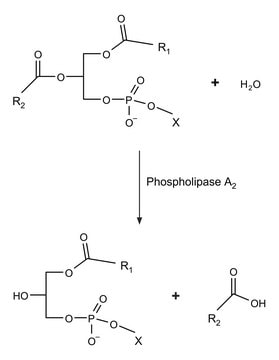1.05691
Lithium hydroxide
98%+, for analysis EMSURE®
Synonym(s):
Lithium hydroxide 98%+
About This Item
Recommended Products
Product Name
Lithium hydroxide 98%+, for analysis EMSURE®
Quality Level
product line
EMSURE®
Assay
≥98.0% (LiOH, acidimetric)
form
solid
potency
210 mg/kg LD50, oral (Rat)
pH
12 (50 °C, 50 g/L in H2O)
mp
423 °C
solubility
110 g/L
density
1.5 g/cm3
bulk density
550 kg/m3
anion traces
chloride (Cl-): ≤0.05%
lithium carbonate (Li2CO3): ≤2.0%
sulfate (SO42-): ≤0.05%
cation traces
Ca: ≤0.02%
Fe: ≤0.002%
K: ≤0.02%
Na: ≤0.05%
heavy metals (as Pb): ≤0.002%
storage temp.
2-30°C
SMILES string
[Li]O
InChI
1S/Li.H2O/h;1H2/q+1;/p-1
InChI key
WMFOQBRAJBCJND-UHFFFAOYSA-M
Application
- A study of the hydration of the alkali metal ions in aqueous solution.: This research explores the hydration properties of alkali metal ions, focusing on lithium ions in aqueous solutions. The study provides insights into the hydration structures and dynamics, which are essential for understanding various chemical processes involving lithium hydroxide (Mähler J, Persson I, 2012) (Mähler and Persson, 2012).
- Determination of markers in digesta and feces by direct current plasma emission spectroscopy.: This paper discusses the use of direct current plasma emission spectroscopy for analyzing markers in biological samples. The method′s applicability for detecting lithium ions among other markers in complex matrices showcases its utility in analytical chemistry and related fields (Combs DK, Satter LD, 1992) (Combs and Satter, 1992).
Analysis Note
Carbonate (as Li₂CO₃): ≤ 2.0 %
Chloride (Cl): ≤ 0.05 %
Sulfate (SO₄): ≤ 0.05 %
Heavy metals (as Pb): ≤ 0.002 %
Ca (Calcium): ≤ 0.02 %
Fe (Iron): ≤ 0.002 %
K (Potassium): ≤ 0.02 %
Na (Sodium): ≤ 0.05 %
Legal Information
Not finding the right product?
Try our Product Selector Tool.
Signal Word
Danger
Hazard Statements
Precautionary Statements
Hazard Classifications
Acute Tox. 4 Oral - Eye Dam. 1 - Skin Corr. 1B
Storage Class Code
8A - Combustible, corrosive hazardous materials
WGK
WGK 1
Flash Point(F)
Not applicable
Flash Point(C)
Not applicable
Certificates of Analysis (COA)
Search for Certificates of Analysis (COA) by entering the products Lot/Batch Number. Lot and Batch Numbers can be found on a product’s label following the words ‘Lot’ or ‘Batch’.
Already Own This Product?
Find documentation for the products that you have recently purchased in the Document Library.
Our team of scientists has experience in all areas of research including Life Science, Material Science, Chemical Synthesis, Chromatography, Analytical and many others.
Contact Technical Service




